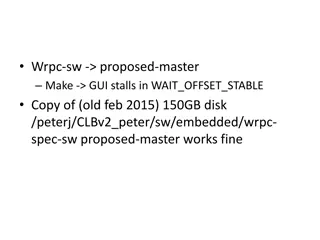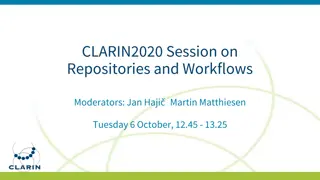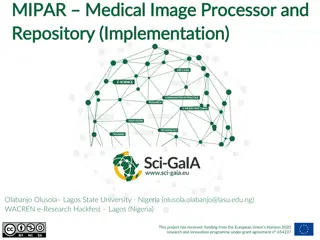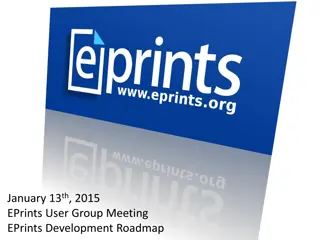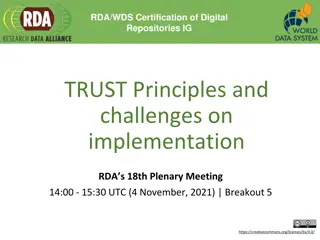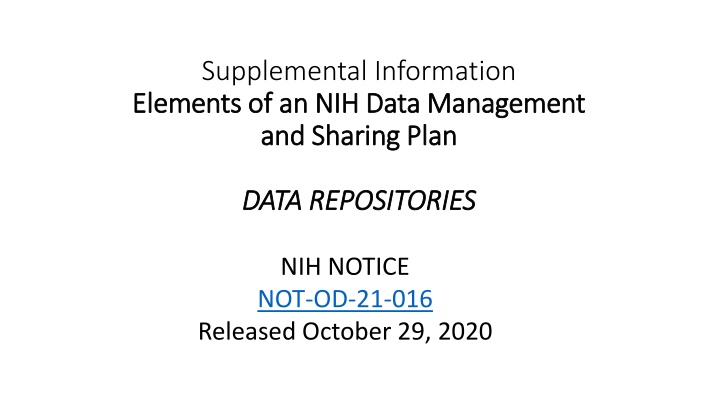
Elements of NIH Data Management and Sharing Plan
Learn about the importance of utilizing data repositories for NIH-funded research projects to enhance data FAIRness and accessibility. Discover how to select appropriate data repositories and desired repository characteristics. Explore the guidelines for choosing a suitable data repository based on NIH recommendations.
Download Presentation

Please find below an Image/Link to download the presentation.
The content on the website is provided AS IS for your information and personal use only. It may not be sold, licensed, or shared on other websites without obtaining consent from the author. If you encounter any issues during the download, it is possible that the publisher has removed the file from their server.
You are allowed to download the files provided on this website for personal or commercial use, subject to the condition that they are used lawfully. All files are the property of their respective owners.
The content on the website is provided AS IS for your information and personal use only. It may not be sold, licensed, or shared on other websites without obtaining consent from the author.
E N D
Presentation Transcript
Supplemental Information Elements of an NIH Data Management Elements of an NIH Data Management and Sharing and Sharing Plan Plan DATA REPOSITORIES DATA REPOSITORIES NIH NOTICE NOT-OD-21-016 Released October 29, 2020
Data Repositories NIH promotes the use of established data repositories deposit in a quality data repository generally improves the FAIRness (Findable, Accessible, Interoperable, and Re-usable) NIH supports many data repositories NIH will not necessarily provide data repositories to preserve and share all data resulting from the research it funds Specific discipline or data-type specific repositories may not exist for every type of data the broader repository ecosystem provides suitable data repositories Researchers may wish to consult experts in their own institutions (e.g., librarians, data managers)
Selecting a Data Repository When NIH specifies a data repository researchers should use the designated data repository(ies) E.g., For some programs and types of data NIH and/or Institute, Center, or Office (ICO) policy(ies) require it A Funding Opportunity Announcements (FOAs) lists specific repositories When NIH does not specify a data repository researchers are encouraged to select a data repository that is appropriate for the data is in accordance with the desired characteristics
Desired Characteristics of Repository Primary consideration should be given to data repositories that are discipline or data-type NIH makes a list of such data repositories available (see https://www.nlm.nih.gov/NIHbmic/domain_specific_repositories.html). If no appropriate discipline or data-type specific repository is available, researchers should consider a variety of other potentially suitable data sharing options: Small datasets (up to 2 GB in size) may be included as supplementary material to accompany articles submitted to PubMed Central (see https://www.ncbi.nlm.nih.gov/pmc/about/guidelines/#suppm) Data repositories, including generalist repositories (see https://www.nlm.nih.gov/NIHbmic/generalist_repositories.html) or institutional repositories, that make data available to the larger research community, institutions, or the broader public. Large datasets may benefit from cloud-based data repositories for data access, preservation, and sharing.
Desirable Characteristics for All Data Desirable Characteristics for All Data Repositories Repositories The characteristics in this section are relevant to all repositories that manage and share data resulting from Federally funded research: A. Unique Persistent Identifiers: Assigns datasets a citable, unique persistent identifier (PID), such as a digital object identifier (DOI) or accession number, to support data discovery, reporting (e.g., of research progress), and research assessment (e.g., identifying the outputs of federally funded research). The unique PID points to a persistent landing page that remains accessible even if the dataset is de-accessioned or no longer available. B. Long-Term Sustainability: Has a plan for long-term management of data, including maintaining integrity, authenticity, and availability of datasets; building on a stable technical infrastructure and funding plans; and having contingency plans to ensure data are available and maintained during and after unforeseen events. C. Metadata: Ensures datasets are accompanied by metadata to enable discovery, reuse, and citation of datasets, using schema that are appropriate to, and ideally widely used across, the community(ies) the repository serves. Domain-specific repositories would generally have more detailed metadata than generalist repositories.
Desirable Characteristics for All Data Desirable Characteristics for All Data Repositories Cont. Repositories Cont. D. Curation and Quality Assurance: Provides, or has a mechanism for others to provide, expert curation and quality assurance to improve the accuracy and integrity of datasets and metadata. E. Free and Easy Access: Provides broad, equitable, and maximally open access to datasets and their metadata free of charge in a timely manner after submission, consistent with legal and ethical limits required to maintain privacy and confidentiality, Tribal sovereignty, and protection of other sensitive data. F. Broad and Measured Reuse: Makes datasets and their metadata available with broadest possible terms of reuse; and provides the ability to measure attribution, citation, and reuse of data (i.e., through assignment of adequate metadata and unique PIDs).
Desirable Characteristics for All Data Desirable Characteristics for All Data Repositories Cont. Repositories Cont. G. Clear Use Guidance: Provides accompanying documentation describing terms of dataset access and use (e.g., particular licenses, need for approval by a data use committee). H. Security and Integrity: Has documented measures in place to meet generally accepted criteria for preventing unauthorized access to, modification of, or release of data, with levels of security that are appropriate to the sensitivity of data. I. Confidentiality: Has documented capabilities for ensuring that administrative, technical, and physical safeguards are employed to comply with applicable confidentiality, risk management, and continuous monitoring requirements for sensitive data.
Desirable Characteristics for All Data Desirable Characteristics for All Data Repositories Repositories end. end. J. Common Format: Allows datasets and metadata downloaded, accessed, or exported from the repository to be in widely used, preferably non-proprietary, formats consistent with those used in the community(ies) the repository serves. K. Provenance: Has mechanisms in place to record the origin, chain of custody, and any modifications to submitted datasets and metadata. L. Retention Policy: Provides documentation on policies for data retention within the repository.
Additional Considerations for Repositories Additional Considerations for Repositories Storing Human Data (even if de Storing Human Data (even if de- -identified) identified) The additional characteristics outlined in this section are intended for repositories storing human data, which are also expected to exhibit the characteristics outlined in Section I, particularly with respect to confidentiality, security, and integrity. These characteristics also apply to repositories that store only de-identified human data, as preventing re-identification is often not possible, thus requiring additional considerations to protect privacy and security.
Additional Considerations for Repositories Storing Additional Considerations for Repositories Storing Human Data (even if de Human Data (even if de- -identified identified) Cont. ) Cont. A. Fidelity to Consent: Employs documented procedures to restrict dataset access and use to those that are consistent with participant consent (such as for use only within the context of research on a specific disease or condition) and changes in consent. B. Restricted Use Compliant: Employs documented procedures to communicate and enforce data use restrictions, such as preventing reidentification or redistribution to unauthorized users. C. Privacy: Implements and provides documentation of appropriate approaches (e.g., tiered access, credentialing of data users, security safeguards against potential breaches) to protect human subjects data from inappropriate access.
Additional Considerations for Repositories Storing Additional Considerations for Repositories Storing Human Data (even if de Human Data (even if de- -identified) identified) end. end. D. Plan for Breach: Have security measures that include a response plan for detected data breaches. E. Download Control: Controls and audits access to and download of datasets (if download is permitted). F. Violations: Has procedures for addressing violations of terms-of- use by users and data mismanagement by the repository. G. Request Review: Makes use of an established and transparent process for reviewing data access requests.










